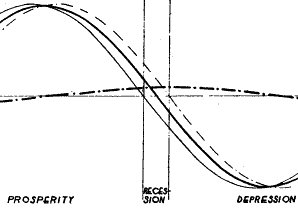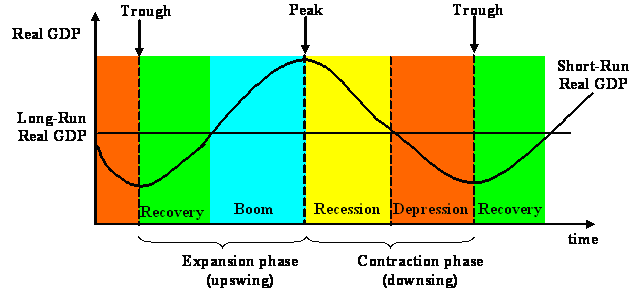|
Back Business cycle theory matters simply because many people believe business cycles exist. This has not been a permanent belief. From the 17th C. and through much of the 19th century, business cycles were not thought of as cycles at all but rather as spells of "crises" interrupting the smooth development of the economy. In later years, especially after the seminal study of Clément Juglar (1862), economists began believing in the regularity of such crises, analyzing how they were spaced apart and associated with changing economic structures. Naturally, not every economic cycle operates on the same yardstick. The following classification, originally conjured up by Schumpeter (1939), defines a few of them by their duration (trough to trough or peak to peak):
Schumpeter also labeled the typical "four-phases" of a cycle: boom- recession-depression-recovery. Starting from the mean, a boom is a rise which lasts until the peak is reached; a recession is the drop from the peak back to the mean; a depression is the slide from the mean down to the trough; a recovery is the rise from the trough back up to the mean. From the mean, we then move up into another boom and thus the beginning of another four-phase cycle. In a sense, any cycle of whatever duration can be described as going through these four phases - otherwise the fluctuations cannot really be described as "cyclical".
The belief of the business cycle theorist is that the economy, somehow, goes through such waves of economic activity. However, what precisely causes the economy to exhibit this type of activity has been a source of much divisive, yet imaginative, exercises. This survey focuses on theories that were developed between 1860s and the 1930s, what may be called the "golden age" of business cycle theory - that is, after the "crisis theories" and before the development of Keynesian macroeconomics. For more on the pre-1860s background, see our business cycle theory school of thought page. For the post-1930s, see our Keynesian business cycle theory page. One of the interesting aspects about the 1860s-1930s period is that there was no consensus on business cycle theory. This was largely because there was nothing that really could be identified as "macroeconomic theory" properly speaking. There were general equilibrium theories, but these tended to focus on allocation and did not delve into aggregate fluctuations. So the field was clear, so to speak, to propose any explanation. Many of these explanations were rather ad hoc conjectures, constructed around empirical facts, rather than being derived from an underlying economic theory. One might even call them "atheoretical theories". As a result, it is misleading to try to classify them as "Classical" or "Neoclassical" - they were not based on either theory.. Business Cycle Theory was a thing apart, rooted more in the historicist-institutionalist traditions. Even when first-class theorists (e.g. Jevons) dabbled in cycles, it was as a separate exercise, unrelated to their their own economic theory. Through much of this period, economic theory and business cycle theories moved on separate, parallel tracks, barely acknowledging each other, and sometimes with hostility. It was really only in the 1920s, after a half-century of parallel existence, that economists finally began to try to figure out a way to connect business cycles to economic theory proper. But these were still tentative connections. When Lowe asked in 1926 - "is business cycle theory even possible at all?" - the answer was still not clear. And it would remain unclear, until the appearance of Keynes's General Theory (1936) unveiled macroeconomic theory. It was precisely the atheoretical character of business cycle theory in the 1860s-1930s period that gave it so much room for a wide variety of explanations. It is difficult to talk of any "progress" in business cycle theory in this period as it went in so many different directions at once. The best we can do is arrange them into a classificatory schema by "type" of explanation - climate-based theories, overinvestment theories, psychological theories, monetary theories, underconsumption theories and shock-based theories. Like all business cycle theorists of old, we should be acquainted with a few empirical facts. First and foremost, empirical evidence shows that through much of the 19th Century, the price level oscillated heavily while output was much less subject to fluctuations. Thus, the early analysis of "cycles" was based precisely on their definition as swings in price levels and not output. However, during the 20th Century, save for a few exceptions, there has normally been a constant upward trend in prices. Prices varied, of course, but only around this upward trend. Output, however, oscillated heavily in the 20th century - thus what was defined as "cyclical" was movements in output: in recessions and depressions, output would collapse; in the recovery and boom, output would increase. Thus, defining the "cycle" or even a "crisis" exclusively as a movement in output is a rather recent phenomenon. The American Institutionalist
economist Wesley C.Mitchell dedicated much of
his life to measuring and analyzing business cycles, thus it is no surprise that
Mitchell's NBER has maintained the most
widely accepted historical record of business cycles in the United States. For a view of
the American business cycle in the past century and a half, we suggest you go to the
US business cycle dates the
NBER keeps on record. The NBER does not record Kondratiev Cycles (or "long waves") - as they, along with many economists, do not believe these cycles exist. Nonetheless, the following four Kondratiev waves have been identified - going through four phases of boom-recession- depression-recovery (the dates and labels are from Kuznets, 1940): (1) The Industrial Revolution (1787-1842) is the most famous Kondratiev wave: the boom began in about 1787 and turned into a recession at the beginning of the Napoleonic age in 1801 and, in 1814, deepened into a depression. The depression lasted until about 1827 after which there was a recovery until 1842. As is obvious, this Kondratiev rode on the development of textile, iron and other steam-powered industries. (2) The Bourgeois Kondratiev (1843-1897): After 1842, the boom reemerged and a new Kondratiev wave began, this one as a result of the railroadization in Northern Europe and America and the accompanying expansion in the coal and iron industries. The boom ended approximately in 1857 when it turned into a recession. The recession turned into a depression into 1870, which lasted until about 1885. The recovery began after that and lasted until 1897. (3) The Neo-Mercantilist Kondratiev (1898-1950?): The boom began about 1898 with the expansion of electric power and the automobile industry and lasted until about 1911. The recession which followed turned into depression in about 1925 which lasted until around 1935. We can assume, that this third wave entered into a recovery immediately afterwards the which one might suspect lasted until around 1950. (4) The Fourth Kondratiev (1950?- 2010?). There has been much debate among believers on the dating the Fourth Wave - largely because of the confusions generated by the low fluctuation in price levels and the issue of Keynesian policies and hence this debate is yet to be resolved. Perhaps the most acceptable set of dates is that the boom began around 1950 and lasted until about 1974 wherein recession set in. When (and if) this recession fell into its depression phase may be more difficult to ascertain (c.1981?), but what has been more or less agreed upon is that 1992 (or thereabouts) the recovery began and has been projected to give way to a boom and thus a new Kondratiev wave around 2010 or so.
|
All rights reserved, Gonçalo L. Fonseca


